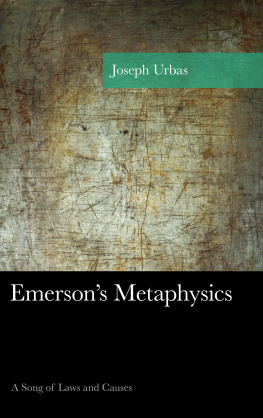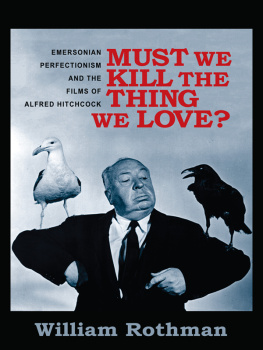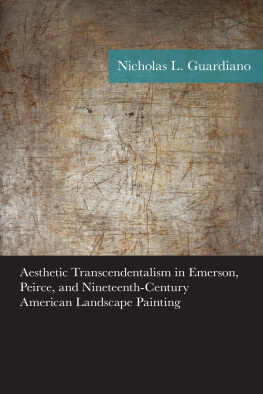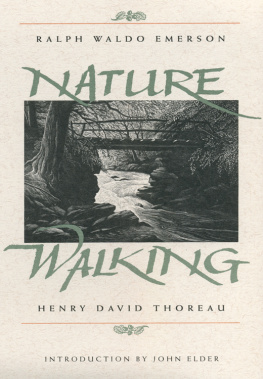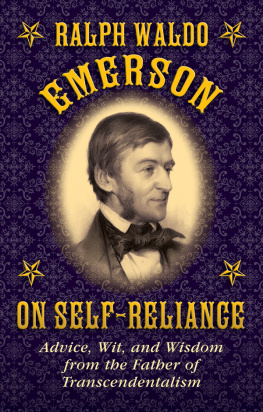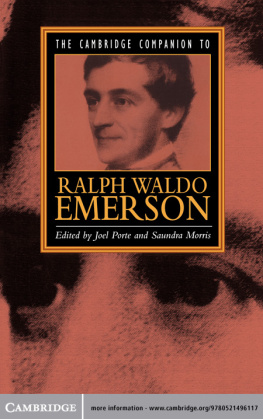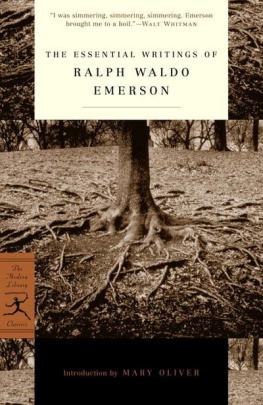Writing beyond Prophecy
Writing beyond Prophecy
EMERSON, HAWTHORNE, and MELVILLE after the AMERICAN RENAISSANCE
Martin Kevorkian

Published by Louisiana State University Press
Copyright 2013 by Louisiana State University Press
All rights reserved
Manufactured in the United States of America
FIRST PRINTING
DESIGNER: Mandy McDonald Scallan
TYPEFACE: Minion Pro
PRINTER: McNaughton & Gunn, Inc.
BINDER: Acme Bookbinding, Inc.
Library of Congress Cataloging-in-Publication Data
Kevorkian, Martin, 1968
Writing beyond prophecy : Emerson, Hawthorne, and Melville after the American Renaissance / Martin Kevorkian.
p. cm.
Includes bibliographical references and index.
ISBN 978-0-8071-4760-3 (cloth : alk. paper) ISBN 978-0-8071-4761-0 (pdf) ISBN 978-0-8071-4762-7 (epub) ISBN 978-0-8071-4763-4 (mobi)
1. Emerson, Ralph Waldo, 18031882Religion. 2. Hawthorne, Nathaniel, 18041864Religion. 3. Melville, Herman, 18191891Religion. 4. Religion and literatureUnited StatesHistory19th century. 5. Literature and societyUnited StatesHistory19th century. 6. United StatesIntellectual life17831865. I. Title.
PS1642.R4K48 2013
814.3dc23
2012010391
The paper in this book meets the guidelines for permanence and durability of the Committee on Production Guidelines for Book Longevity of the Council on Library Resources. 
for
Colacurcio, Packer, and Wortham
active souls
the flowers placed in the sanctuary
for todays service
are in their honor
Contents
CHAPTER 1
Writing after the Minister
CHAPTER 2
Emersons Call to Worship
CHAPTER 3
Hawthornes Sermon
CHAPTER 4
Melvilles Benediction
Prelude
Writing beyond Prophecy begins with a relic, preserved thanks to my colleague Douglas Bruster, and still relevant thanks to a blind spot that literary studies of the American Renaissance are only just beginning to rectify: A Monument to Melville, in the form of a Times Literary Supplement review essay, was stamped Recd by the Chairmans Office, Dept. of English, University of Texas on January 25, 1972. Featured in the review is a book allegedly entitled Progress into Science. When the issue reached the desk of Joe Moldenhauer, he circled the word Science, and penned in Silence. Moldenhauer, the eminent Thoreauvian, was correct about the title of the Melville study under review. But thirty years later, it still seems worth noting that both the TLS, reverting to the default association of progress with science, and the author of Progress into Silence, associating the later life of Melville with cessation of writing, were wrong.
Both science and silence play a role in the story to be told here of later Emerson, Hawthorne, and Melville, but neither ence gets the last word on how these careers progressed. Still voicing his restlessness a quarter of a century after Moby-Dick (1851), Melville speaks of both technological progress and spiritual silence:
They wire the worldfar under sea
They talk; but never comes to me
A message from beneath the stone.
(NN 12:49798)
Robert Penn Warren glosses these lines as expressing the failure of science to solve ultimate mysteries (Selected Poems, 410). As Andrew Delbanco puts it in Melville: His World and Work (2005): Science, so full of promise for its insights into the processes of nature, could do nothing to satisfy what William James would soon call the craving of the heart to believe that behind nature there is a spirit whose expression nature is, and Clarel was Melvilles reproach of science for its failure to slake his craving (282). Clarel, Melvilles eighteen-thousand-line Poem and Pilgrimage in the Holy Land (1876), laments the lack of hope to be found through prosing Science (NN 12:113) and earnestly seeks its implicit antidote: what we might call, after Emerson, meter-making religion. In his summative study, Emerson, Lawrence Buell asks scholars living in our own wired world to face a fact: Like it or not, there is no getting rid of religion as a force in human affairs. If you think its nothing more than the opiate of others, youre likely to misunderstand yourself as well as them. Especially if youre trying to come to terms with so religio-centric a culture as the United States was in the early nineteenth centuryand indeed still is (15960). And for those of us who are fortunate to serve in the teaching profession, the academic narrative of secular triumphalism can make it difficult to understand our students: as Joanna Brooks reminds in her 2010 ALH piece, From Edwards to Baldwin, We know, as do the undergraduates we face in our lecture halls, that religion matters, has always mattered, and will continue to matter, and that, moreover, what Edmund Morgan memorably described as faith lived in its proper imperfection is capable of producing great art. It is time for new stories. How, then, shall we proceed? (441).
The story of Writing beyond Prophecy: Emerson, Hawthorne, and Melville after the American Renaissance focuses on how each of these authors initially chose a self-reliant literary vocation over and against the calling of the minister, as the study traces, in the later careers, the fallout of that early prophetic confidence. Thus, to some extent, this book tells a story of these authors relations to organized religion. Having entered the language in 1843, contemporaneous to a romantic individualism that would tend to regard it with hostility, the phrase today bears inescapably pejorative associations. Especially when paired with religion, organized has devolved from its earliest significance, in reference to something living, organic, provided with vital organs, to something systematic, mechanical, and dead. A 2001 OED entry typifies the contemporary usage: He was hostile to organized religion, which he considered oppression through the fetishization of words. This twenty-first-century characterization typifies that pejorative usage precisely through concepts that Emerson forcefully articulated in 1838, in his assault on historical Christianity and its treatment of the figure of Jesus: The idioms of his language, and the figures of his rhetoric, have usurped the place of his truth; and churches are not built on his principles, but on his tropes (CW 1:81). Yet however vigorously Emerson pursued his thesis against verbal idolatry, did he live out his life in the belief that organized religion should die? And if not, on what terms might Emerson, and those he inspired to an aggressive literary prophecy, come to terms with the figure of the minister? As Colin Jager observes in Varieties of Secularism in a Secular Age (2010), a recognizably modern notion of literariness, as something simultaneously distinct from Christianity and yet remarkably proximate to it, emerges for the first time during the Romantic era (168). How did Emerson, Hawthorne, and Melville negotiate that proximity, and with what degree of comfort did they pursue the substitution of the distinct new discourse for the faith traditions into which they had been born?
If we are Emersons Ghosts, as Randall Fuller has evocatively suggested in the 2007 publication of that title, we might wish to linger a bit, even in spite of the Sages famously serene smile, to wonder what might have haunted him. Emerson was, as Fuller notes, in some ways markedly unlike the subsequent (and largely secular) American Scholars (
Next page


